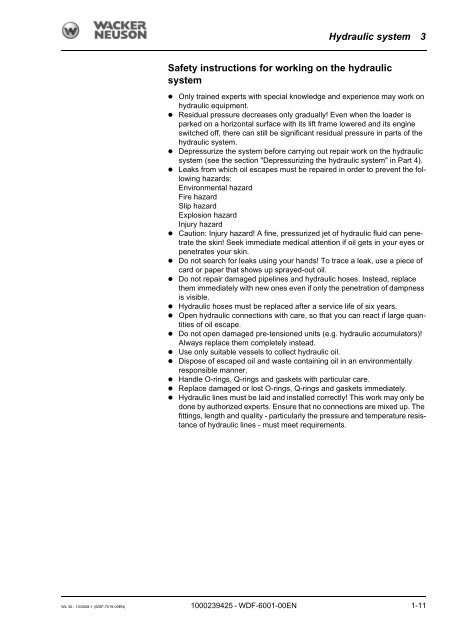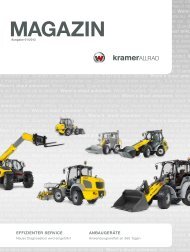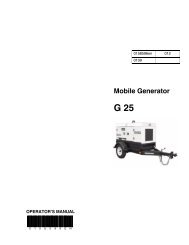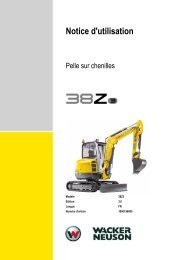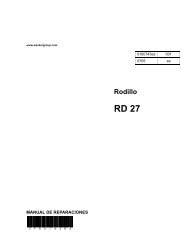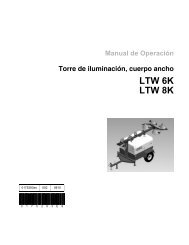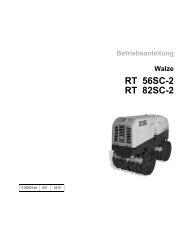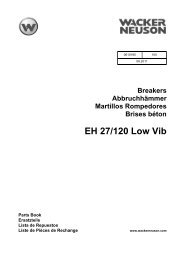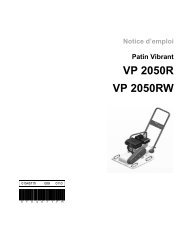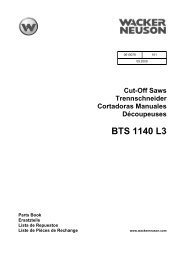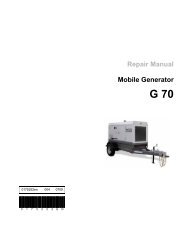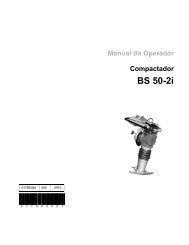- Page 1 and 2: © 2008 Wacker Neuson SE - 80809 M
- Page 3 and 4: Service address and spare parts WL
- Page 5 and 6: VI Violet WH White X Plug connector
- Page 7 and 8: Part 1 Safety 1 Repair work (comple
- Page 9 and 10: 4.3 Rear axle. . . . . . . . . . .
- Page 11 and 12: A Additional weight Replacement . .
- Page 13 and 14: Hose book . . . . . . . . . . . . .
- Page 15 and 16: Turning the bearing see Engine, cle
- Page 17 and 18: © 2008 Wacker Neuson SE - 80809 M
- Page 19 and 20: WL 30 - 10/2008-1 (WDF-7019-00EN) 1
- Page 21 and 22: 1 Repair work (complete vehicle) .
- Page 23 and 24: WL 30 - 10/2008-1 (WDF-7019-00EN) 1
- Page 25: Safety instructions for working on
- Page 29 and 30: WL 30 - 10/2008-1 (WDF-7019-00EN) 1
- Page 31 and 32: WL 30 - 10/2008-1 (WDF-7019-00EN) 1
- Page 33 and 34: WL 30 - 10/2008-1 (WDF-7019-00EN) 1
- Page 35 and 36: WL 30 - 10/2008-1 (WDF-7019-00EN) 1
- Page 37 and 38: A Axles Safety instructions . . . .
- Page 39 and 40: © 2008 Wacker Neuson SE - 80809 M
- Page 41 and 42: WL 30 - 10/2008-1 (WDF-7020-00EN) 1
- Page 43 and 44: 1 Technical data . . . . . . . . .
- Page 45 and 46: Engine Perkins 4-cylinder Diesel e
- Page 47 and 48: WL 30 - 10/2008-1 (WDF-7020-00EN) 1
- Page 49 and 50: Special tightening torques General
- Page 51 and 52: Variable displacement pump, driving
- Page 53 and 54: The gear pump delivers 19 cm3 per r
- Page 55 and 56: Meaning and position of the safety
- Page 57 and 58: Sticker Meaning WL 30 - 10/2008-1 (
- Page 59 and 60: Fig. 2 Stickers located on the righ
- Page 61 and 62: 7.1 Test pressure gauge WL 30 - 10/
- Page 63 and 64: 8.1 Insertion tool WL 30 - 10/2008-
- Page 65 and 66: 8.5 Electrical contact key WL 30 -
- Page 67 and 68: Enter every replaced hydraulic line
- Page 69 and 70: D Driving bolts . . . . . . . . . .
- Page 71 and 72: © 2008 Wacker Neuson SE - 80809 M
- Page 73 and 74: Hydraulic system WL 30 - 10/2008-1
- Page 75 and 76: 1 Complete vehicle. . . . . . . . .
- Page 77 and 78:
1.1 Inspection log Vehicle data Veh
- Page 79 and 80:
2.1 Checking and adjusting the valv
- Page 81 and 82:
Installing the cylinder head cover
- Page 83 and 84:
If a fault is found: WL 30 - 10/200
- Page 85 and 86:
Symptom Possible cause Remedy Engin
- Page 87 and 88:
3.1 Checking and adjusting the star
- Page 89 and 90:
Adjusting the pressure cut-off WL 3
- Page 91 and 92:
WL 30 - 10/2008-1 (WDF-7021-00EN) 1
- Page 93 and 94:
WL 30 - 10/2008-1 (WDF-7021-00EN) 1
- Page 95 and 96:
Adjusting the control commencement
- Page 97 and 98:
Checking the emergency steering cap
- Page 99 and 100:
WL 30 - 10/2008-1 (WDF-7021-00EN) 1
- Page 101 and 102:
Symptom Possible cause Remedy Suppl
- Page 103 and 104:
4.1 Inspecting the differential loc
- Page 105 and 106:
4.3 Troubleshooting on the drive Sy
- Page 107 and 108:
Checking and adjusting the curling
- Page 109 and 110:
6.1 Checking the heater Start the
- Page 111 and 112:
7.1 Checking the generator Requirem
- Page 113 and 114:
7.4 Testing the fuel level sensor R
- Page 115 and 116:
B Belt buckle circuit Testing . . .
- Page 117 and 118:
© 2008 Wacker Neuson SE - 80809 M
- Page 119 and 120:
WL 30 - 10/2008-1 (WDF-7022-00EN) 1
- Page 121 and 122:
1 Complete vehicle. . . . . . . . .
- Page 123 and 124:
8.2.11 Replacing the fuel level sen
- Page 125 and 126:
1.1 Helpful tips WL 30 - 10/2008-1
- Page 127 and 128:
2.1 Engine (as supplied) 2.1.1 Engi
- Page 129 and 130:
Releasing the engine mounts Fig. 7
- Page 131 and 132:
Fig. 15 Connections (left) WL 30 -
- Page 133 and 134:
Spare parts and auxiliary equipment
- Page 135 and 136:
Fig. 24 Clutch PA flange attachment
- Page 137 and 138:
Checking the air supply and oil lev
- Page 139 and 140:
Spare parts and auxiliary equipment
- Page 141 and 142:
2.3 Air filter system 2.3.1 Replaci
- Page 143 and 144:
Checking the position of the air fi
- Page 145 and 146:
Removing the main fuel filter Fig.
- Page 147 and 148:
Removing the fuel feed pump Fig. 44
- Page 149 and 150:
2.5 Exhaust system 2.5.1 Replacing
- Page 151 and 152:
WL 30 - 10/2008-1 (WDF-7022-00EN) 1
- Page 153 and 154:
Depressurizing the hydraulic system
- Page 155 and 156:
Requirements Ensure the following:
- Page 157 and 158:
Cleaning the guide bush Remove the
- Page 159 and 160:
WL 30 - 10/2008-1 (WDF-7022-00EN) 1
- Page 161 and 162:
3.2.3 Replacing the annular shaft s
- Page 163 and 164:
Removing the variable displacement
- Page 165 and 166:
Fig. 76 Steering cover Fig. 77 Prio
- Page 167 and 168:
Spare parts and auxiliary equipment
- Page 169 and 170:
Requirements Ensure the following:
- Page 171 and 172:
Installing the steering cylinder at
- Page 173 and 174:
Spare parts and auxiliary equipment
- Page 175 and 176:
Requirements Ensure the following:
- Page 177 and 178:
3.5.2 Sealing the gear pump Require
- Page 179 and 180:
3.5.3 Removing the control valve Re
- Page 181 and 182:
Inserting the control valve Instal
- Page 183 and 184:
Removing the coils Unscrew 1 nut (
- Page 185 and 186:
WL 30 - 10/2008-1 (WDF-7022-00EN) 1
- Page 187 and 188:
Removing the cross controller Insta
- Page 189 and 190:
Installing the lifting cylinder, ro
- Page 191 and 192:
Spare parts and auxiliary equipment
- Page 193 and 194:
Installing the tipping cylinder, ro
- Page 195 and 196:
Spare parts and auxiliary equipment
- Page 197 and 198:
Detaching the lines Remove the plu
- Page 199 and 200:
WL 30 - 10/2008-1 (WDF-7022-00EN) 1
- Page 201 and 202:
4.1 Replacing the drive shaft Requi
- Page 203 and 204:
Removing the hydraulic lines Reliev
- Page 205 and 206:
Fig. 174 Front axle support WL 30 -
- Page 207 and 208:
4.3 Rear axle 4.3.1 Removing the re
- Page 209 and 210:
WL 30 - 10/2008-1 (WDF-7022-00EN) 1
- Page 211 and 212:
Connecting the hydraulic lines on t
- Page 213 and 214:
5.1 Service brake 5.1.1 Replacing t
- Page 215 and 216:
Requirements Ensure the following:
- Page 217 and 218:
WL 30 - 10/2008-1 (WDF-7022-00EN) 1
- Page 219 and 220:
Spare parts and auxiliary equipment
- Page 221 and 222:
Spare parts and auxiliary equipment
- Page 223 and 224:
6.2.4 Replacing the engine hood Req
- Page 225 and 226:
6.2.6 Emergency release of the engi
- Page 227 and 228:
Preparing the self-aligning bearing
- Page 229 and 230:
Installing the self-aligning bearin
- Page 231 and 232:
WL 30 - 10/2008-1 (WDF-7022-00EN) 1
- Page 233 and 234:
WL 30 - 10/2008-1 (WDF-7022-00EN) 1
- Page 235 and 236:
Disconnecting electrical cables Un
- Page 237 and 238:
Securing the operator's platform Co
- Page 239 and 240:
WL 30 - 10/2008-1 (WDF-7022-00EN) 1
- Page 241 and 242:
6.5 Load arm 6.5.1 Replacing the co
- Page 243 and 244:
Connecting the hydraulic lines Spar
- Page 245 and 246:
Drive in a new bearing from the out
- Page 247 and 248:
Spare parts and auxiliary equipment
- Page 249 and 250:
WL 30 - 10/2008-1 (WDF-7022-00EN) 1
- Page 251 and 252:
Spare parts and auxiliary equipment
- Page 253 and 254:
7.1 Seat 7.1.1 Replacing the driver
- Page 255 and 256:
WL 30 - 10/2008-1 (WDF-7022-00EN) 1
- Page 257 and 258:
Installing the driver's canopy WL 3
- Page 259 and 260:
Removing the document compartment I
- Page 261 and 262:
Removing the Bowden cables Unscrew
- Page 263 and 264:
WL 30 - 10/2008-1 (WDF-7022-00EN) 1
- Page 265 and 266:
WL 30 - 10/2008-1 (WDF-7022-00EN) 1
- Page 267 and 268:
Removing the windshield washer cont
- Page 269 and 270:
Spare parts and auxiliary equipment
- Page 271 and 272:
WL 30 - 10/2008-1 (WDF-7022-00EN) 1
- Page 273 and 274:
Preparation for bonding Place the
- Page 275 and 276:
WL 30 - 10/2008-1 (WDF-7022-00EN) 1
- Page 277 and 278:
Installing the instrument steering
- Page 279 and 280:
8.1 Generator, battery and motors 8
- Page 281 and 282:
8.1.3 Replacing the rear windshield
- Page 283 and 284:
Installing the windshield wiper mot
- Page 285 and 286:
Spare parts and auxiliary equipment
- Page 287 and 288:
Replacing the ignition lock Unscre
- Page 289 and 290:
Remove the plug (Fig. 387,3). Unsc
- Page 291 and 292:
WL 30 - 10/2008-1 (WDF-7022-00EN) 1
- Page 293 and 294:
8.3 Relays, coils and fuses 8.3.1 R
- Page 295 and 296:
Removing the solenoid valve Mark t
- Page 297 and 298:
Replacing the indicator lamp WL 30
- Page 299 and 300:
8.4.4 Replacing the audible warning
- Page 301 and 302:
Spare parts and auxiliary equipment
- Page 303 and 304:
Fig. 409 Rear headlight Removing th
- Page 305 and 306:
Spare parts and auxiliary equipment
- Page 307 and 308:
A Additional weight Replacement . .
- Page 309 and 310:
O Operator's platform Installing .
- Page 311 and 312:
© 2008 Wacker Neuson SE - 80809 M
- Page 313 and 314:
WL 30 - 10/2008-1 (WDF-7023-00EN) 1
- Page 315 and 316:
1 Hydraulic circuit diagram . . . .
- Page 317 and 318:
WL 30 - 10/2008-1 (WDF-7023-00EN) 1
- Page 319 and 320:
WL 30 - 10/2008-1 (WDF-7023-00EN) 1
- Page 321 and 322:
Component list WL 30 Date: 06.08.08
- Page 323 and 324:
WL 30 - 10/2008-1 (WDF-7023-00EN) 1
- Page 325 and 326:
WL 30 - 10/2008-1 (WDF-7023-00EN) 1
- Page 327 and 328:
WL 30 - 10/2008-1 (WDF-7023-00EN) 1
- Page 329 and 330:
Plug assignment, multi-function lev
- Page 331 and 332:
WL 30 - 10/2008-1 (WDF-7023-00EN) 1
- Page 333 and 334:
WL 30 - 10/2008-1 (WDF-7023-00EN) 1
- Page 335 and 336:
WL 30 - 10/2008-1 (WDF-7023-00EN) 1
- Page 337 and 338:
A Assignment Combination switch . .
- Page 339 and 340:
© 2008 Wacker Neuson SE - 80809 M
- Page 341 and 342:
WL 30 - 10/2008-1 (WDF-7024-00EN) 1
- Page 343 and 344:
1 Engine workshop manual (example)
- Page 345 and 346:
WL 30 - 10/2008-1 (WDF-7024-00EN) 1
- Page 347 and 348:
Electric Drives and Controls Hydrau
- Page 349 and 350:
Electric Drives and Controls Hydrau
- Page 351 and 352:
WL 30 - 10/2008-1 (WDF-7024-00EN) 1
- Page 353 and 354:
WL 30 - 10/2008-1 (WDF-7024-00EN) 1
- Page 355 and 356:
E Engine Workshop manual (example)


